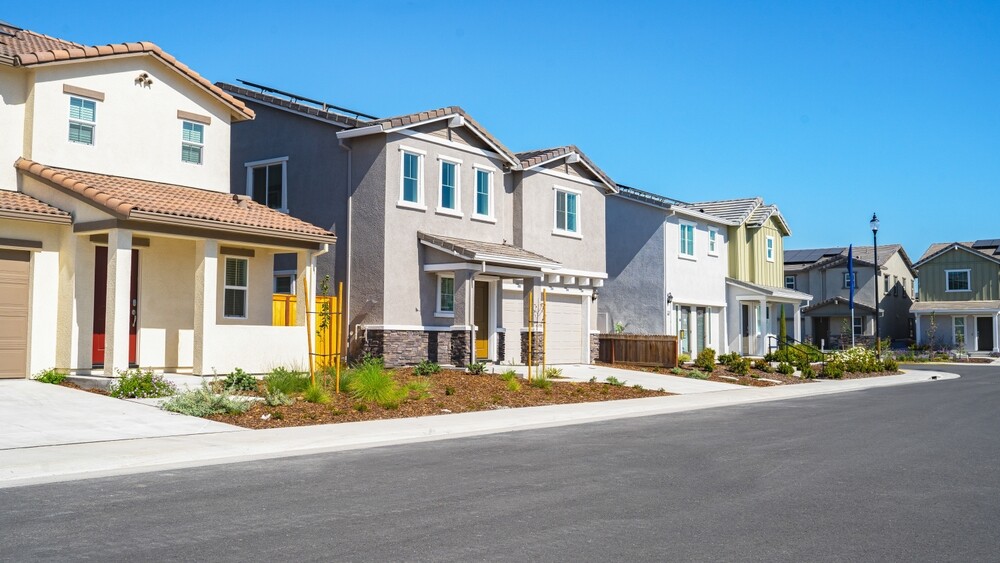Housing affordability is an ongoing challenge, one that has been exacerbated in the last few years by rising interest rates and home prices. One alternative that is proving popular is the build-to-rent (BTR) model, which includes communities with apartment-style or single-family homes, or a combination of both.
A recent ULI member-exclusive webinar titled “Build-to-Rent 101: Understanding market dynamics and the development process,” addressed the rising popularity of BTR communities. Panelists included Don Walker, managing principal, John Burns Research and Consulting; Michael Finch, executive vice president and principal, SVN SFR Capital Management; Beth O’Brien, founder and CEO at Encore Finance; and Teresa Ruiz, principal and studio director, TCA Architects. The panel was moderated by Sibley Fleming, vice president and editor in chief of Urban Land magazine.
ULI members responded to the popular webinar with more questions than the panel could address in the allotted time, and the panelists have agreed to answer them here in this Q&A format.
ULI: How do the amenities differ for build-to-rent and apartments? (ULI Member Beatrice Fu, ULI Los Angeles)
Michael Finch: This depends on what category you consider BTR. If you consider BTR the horizontal or cottage-style product, then they are akin to apartments, with luxury pools, club houses, gyms, etc. As product varies from the horizontal product to more traditional attached townhomes and detached single-family homes, then the home is really the amenity. In these communities, it is more important to have walking trails, green space, and pools depending on the location and size of the community.
Don Walker: At a high level, the BTR sector has generally avoided the amenity wars that impacted Class-A apartment developers over the years. So generally, BTR amenity packages are more modest in size and scope than what is often provided in Class-A projects. That said, we are seeing more BTR projects with a larger number of units with multiple product lines, and these communities are being built with larger amenity centers to accommodate more people and a larger variety of interests.
Teresa Ruiz: It varies based on location and competitive product around. In general, we see the BTR amenities being more resort-like if competing against Class-A multifamily products, and more family-oriented if competing against other garden-style products.
Beth O’Brien: I would add a quote from one of my BTR clients: “Our amenities are the front door and the back yard.” What she was indicating is that not all communities have a pool house or dog run, but hers all have single-family detached houses, which is how their residents want to live.
ULI: How are lenders and other financial establishments viewing build-to-rent as opposed to typical multifamily? Are we seeing higher returns on build-to-rent due to typically higher rents? (ULI Member Justin Kirby, ULI Charlotte)
Finch: In true BTR homes, the price per foot on rents is usually lower, but that is due to the homes typically being 1,400 to 1,800 square feet (3-4 bedroom), as opposed to cottage style or horizontal product between 600 and 1,200 square feet (1-2 bedroom), which competes with typical stacked apartments. The tenants in true single-family BTR homes tend to be stickier, as they have more stuff, kids go to local schools, and the families are involved in the local community. Disposition cap rates have largely been apples to apples once BTR communities are stabilized and sell on the income basis, as multifamily does.
Walker: For all BTR types, I believe investors factor in, to the best of their ability based on experience and market insights, net operating income, factoring in and/or considering all expenses such as taxes, management, marketing, repairs and maintenance, turnover, reserves, etc., and apply a cap rate based on the expected income. I do not usually hear any correlation of higher rents to higher returns particularly if the investor is considering risk adjusted returns.
Turnover is generally lower in BTR than multifamily, but that does vary by product type and demographic profile. In fact, our surveys usually show that age-targeted and age-restricted BTR communities have the lowest turnover. Horizontal apartment communities generally have turnover rates closer to multifamily, but we have also seen another extreme where the most expensive BTR communities can also have high turnover as those residents are usually in a community for one or two years while they evaluate buying a home in a new area or are waiting for their new home to be built.
ULI: Do you see multiplexes and other missing middle housing options being successful for BTR strategies, as single-family homes are unsustainable to build? (ULI Member Abdur Chatni, ULI Toronto)
O’Brien: The short answer is yes, but not because it is unsustainable to build single-family residential. It has more to do with density that is appropriate for the location. As Don notes, we are in desperate need of supply and should be balancing density with needs and wants in the various locations.
Finch: This is a tough one, as it all starts at the land. The country needs affordable housing in the multifamily space as well, but it is just as expensive to build a Class-B apartment building as Class-A. But the tenants can’t afford the rents due to costs to construct, which is why only Class-A buildings are built. So until the land prices come down or cities or governments really get behind affordable missions with zoning, it seems unattainable to build any affordable housing at this point. There is arguably a need in this country for single-family homes, far more than multifamily units in my opinion. BTR homes can be built in affordable areas where there is need, again if the land is priced right.
Ruiz: We are seeing BTR townhome products as part of larger multifamily development as ways to interface with adjacent single-family residential products.
Walker: We are working on more and more BTR projects that incorporate a few different product lines, including horizontal apartments, single-level rowhomes, townhomes, and single-family detached homes, sometimes alongside or adjacent to traditional apartments. These larger communities with multiple product offerings can fulfill the housing needs of a variety of demographic profiles. Relative to traditional for-sale single-family detached and attached homes (townhomes), BTR homes are usually much smaller and can be on smaller lots, equating to a more enhanced use of land and resources via the higher density.
ULI: Can anyone comment on the differences in construction costs for build-to-rent products, as compared with either for-sale homes or more traditional apartments? (ULI Member Andrew Nelson, ULI Orange County/Inland Empire)
Finch: The cost to build is roughly the same. That being said, home builders have a lot of opportunity to save on costs when building and selling 8-12 homes per month to one buyer with streamlined and consistent floor plans compared to building to the for-sale market, which is averaging 3.6 sales per month currently and requires higher hold times, higher fees, higher marketing budgets, higher sales team expenses, and higher labor costs since there is no guarantee the subs will be needed every month pending demand, greater variety of floor plans and unit mix.
Ruiz: We see similar construction costs of the for-sale counterpart. Although one might be tempted to adjust finishes, we need to consider the durability of the product to mitigate turn cost.
ULI: Might the panel address lease longevity and retention for BTR? Since there is a transitional element to this type of rental, might there be less retention than traditional multifamily with smaller units? (ULI Member Ilan Jacobsohn, ULI New York)
O’Brien: We underwrite significantly higher retention for BTR versus multifamily and our experience bears that out. We see turnover continuing to get longer as we have a larger data set. We attribute this to families opting more for BTR assets and being dependent on schools and expansion into larger spaces. Once you own the outdoor furniture and extra possessions, it gets harder to move!
Finch: Retention has already proven to be significantly higher for BTR product compared to apartments or horizontal BTR cottage product. The average tenure in a BTR community is over four years for a tenant, compared to average tenure of apartment tenants, which is around 15 months. It is well known that single-family tenants stay longer than apartment tenants across the board; this is not even a question for debate at this point.
Walker: Retention is higher in BTR than multifamily, but retention does vary by product, where horizontal apartments have turnover rates closer to traditional multifamily apartments (45-50 percent). Most BTR builders/operators expect typical turnover to be around 35 percent when underwriting new deals. Age-targeted and age-restricted BTR projects experience turnover rates that range from 10-12 percent, based on our surveys.
ULI: When bringing a BTR as the first of its kind into a community, what are the greatest challenges you face from remonstrators during a public forum? (ULI Member Jessica Miller)
Ruiz: Early outreach and public education are key to project success. Many jurisdictions are unfamiliar with this product. Meeting with authorities earlier as part of the educational process is important.
Finch: Unfortunately, the sentiment from neighbors today, when cities consider any rental product, is roughly the same. If it isn’t communicated properly that the BTR community is going to be single-family homes within a subdivision, neighbors tend to have a negative view of renters.
Walker: Sadly, there is a bias that BTR renters will bring down the value of neighborhoods because most often, local community groups do not understand BTR and their tenants. However, the typical BTR community in our database of nearly 1,600 active communities contains 130 units, and at a cost of about $325,000 or more per home, we are talking about investments of roughly $40 million. The owners of these communities are going to protect their massive investments by maintaining the homes, maintaining the yards, and providing great service to their tenants. I believe that in the long run, BTR communities and homes will likely maintain an appearance at least as nice as the owned homes nearby, if not better. Also, tenants have much more affluence and education than many people perceive.










